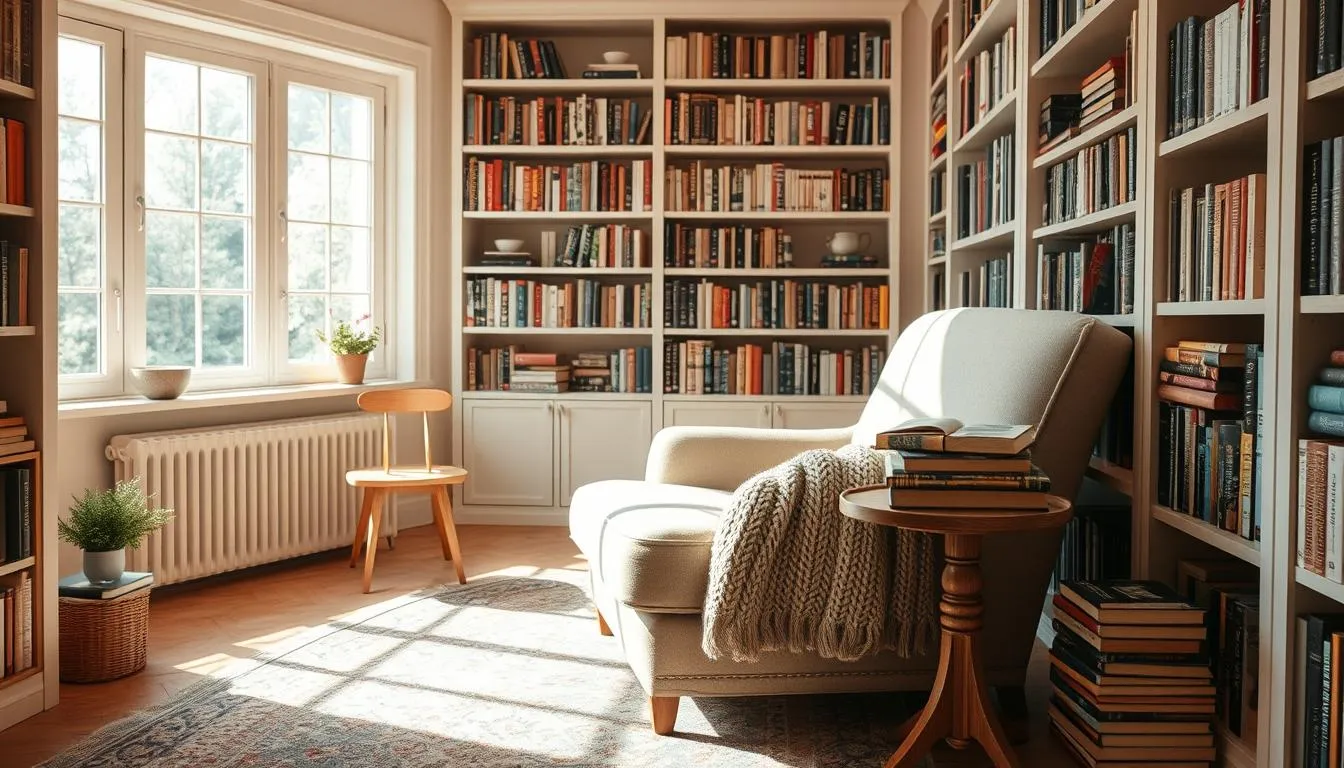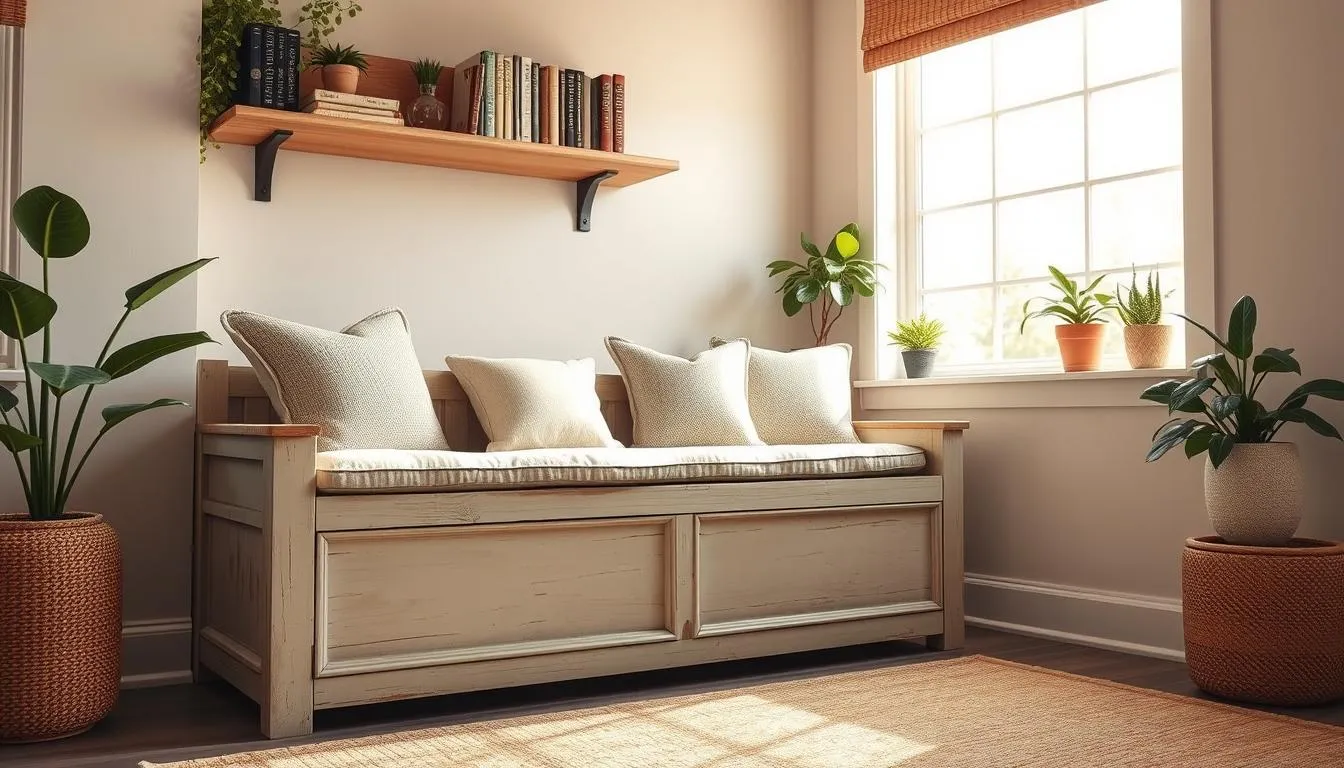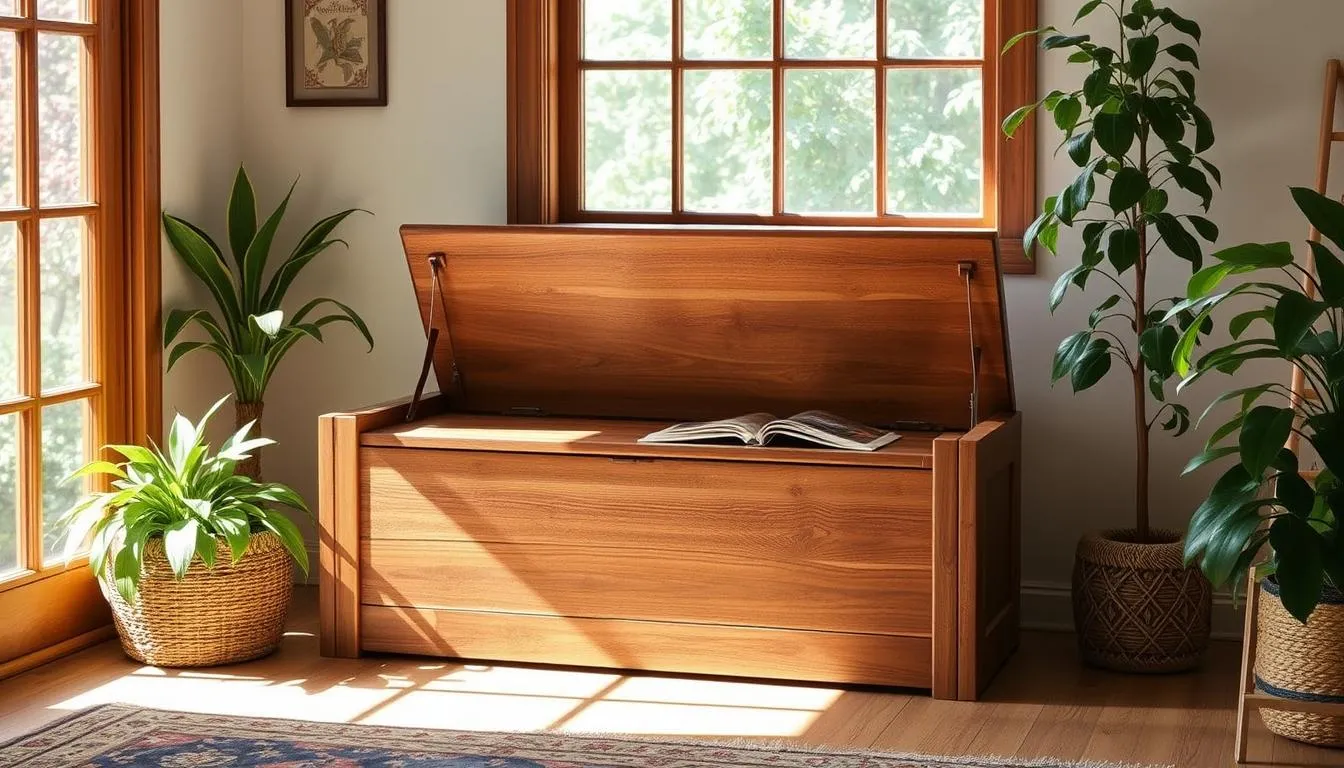Some corners of our homes quietly beg for attention. I still remember turning a dark basement alcove into a small haven where late afternoons felt softer and time slowed down. That transformation taught me something profound: a well-designed DIY reading nook isn’t just furniture—it’s a sanctuary that beckons you to pause, breathe, and lose yourself in a good story.
This comprehensive guide makes it simple to create cozy reading spaces that actually get used. Research from the American Library Association shows that dedicated reading spaces increase reading time by 47% and improve focus by 38%. Whether you dream of a built-in window seat with hidden storage, a minimalist corner retreat, or a kid-friendly book fort, you’ll find detailed blueprints, material lists, and real-world cost breakdowns.
You’ll discover how to transform unused spaces like stair landings, bedroom corners, or basement alcoves into inviting reading sanctuaries. Learn professional techniques for space planning, lighting design, and storage integration that maximize both comfort and functionality.
For enhanced workspace integration, complement your reading nook with DIY floating desk installations and explore built-in storage solutions.
Expect detailed building guides, precise measurements, safety protocols, and budget-conscious alternatives that help you create a custom look without custom prices. By the end, you’ll have the knowledge to plan, build, and style a reading nook that rivals professional designs while perfectly fitting your space and lifestyle.
For optimal ambiance, enhance your nook with smart lighting solutions and explore minimalist design inspiration.
Key Takeaways
- Master space planning with detailed measurements and traffic flow analysis
- Choose from five distinct nook types: window seats, corner benches, closet conversions, built-ins, and portable solutions
- Access complete material lists and cost breakdowns for budgets from $150 to $1,500
- Learn professional construction techniques for durability and safety
- Implement ergonomic seating principles for maximum reading comfort
- Design comprehensive lighting schemes for day and night reading
- Create stylish storage solutions that keep books organized and accessible
- Apply design principles for modern, bohemian, minimalist, and traditional aesthetics
Space Planning and Measurements: Foundation of Your Perfect Reading Nook
Measure twice, build once. The most beautiful reading nook becomes a costly mistake if it doesn’t fit your space or lifestyle. Start with thorough space analysis to ensure your finished nook enhances rather than obstructs your home’s flow.

For additional storage ideas, check out our multi-purpose stair storage and tension rod room dividers.
Understanding Standard Reading Nook Dimensions
Base your measurements on proven ergonomic principles. According to research from the OSHA, a comfortable reading seat requires specific minimum dimensions based on anthropometric data from thousands of users:
- Seat depth: 18-24 inches for adult comfort
- Seat height: 16-18 inches from floor
- Back support: 14-16 inches high, angled 10-15 degrees
- Clearance: 30-36 inches in front for easy access
- Width: Minimum 30 inches for single occupancy, 48-60 inches for sharing
For window seat applications, measure the window opening width and subtract 2 inches for cushion overhang. Standard twin bed dimensions (38” x 75”) work perfectly for many alcove spaces when oriented lengthwise or crosswise.
Traffic Flow and Accessibility Planning
Map your room’s traffic patterns before finalizing nook placement. Use painter’s tape to outline proposed dimensions on the floor, then live with the layout for several days. Notice how family members navigate the space—successful reading nooks feel naturally integrated, not like obstacles.
Consider door swings, furniture clearances, and emergency egress requirements. In bedrooms, maintain 36-inch walkways to closets and bathrooms. For basement installations, verify mechanical access remains unobstructed.
Measuring Awkward Spaces: Windows, Corners, and Alcoves
Transform challenging spaces into reading gold with strategic measuring. Bay windows, dormer alcoves, and under-stair areas often provide perfect nook opportunities with proper planning.
For bay windows, measure the interior width at multiple points—older homes rarely have perfectly square openings. Note the window sill height and depth, as these determine whether you’ll build over or around existing features.
Corner installations require careful attention to wall plumb and square. Measure diagonally from corner to corner to identify out-of-square conditions that affect cabinet fitting and appearance.
Five DIY Reading Nook Types: Complete Building Guides
Choose your adventure based on skill level, budget, and space constraints. Each nook type offers unique advantages and specific construction challenges.

Type 1: Window Seat with Storage (Skill Level: Intermediate)
Materials List:
- 3/4” Baltic birch plywood: 2 sheets ($120)
- 2x4 framing lumber: 8 pieces ($32)
- Drawer slides: Heavy-duty 18” ($48)
- Hardware: Hinges, pulls, screws ($35)
- Cushion foam: 4” high-density ($65)
- Fabric: 3 yards upholstery weight ($45) Total Cost: $345
Construction Steps:
-
Frame Construction: Build a 2x4 frame sized to your window opening minus 1/2” on each side. Use pocket screws for strong, hidden joints.
-
Carcass Assembly: Cut plywood panels for top, bottom, and sides. Create a face frame from 1x3 hardwood strips to hide plywood edges.
-
Storage Integration: Install drawer boxes using Baltic birch with dovetail or rabbet joints. Mount on full-extension slides for easy access to stored items.
-
Anchoring: Secure the frame to wall studs using 3” wood screws through the back rail. This creates the built-in appearance and ensures safety.
-
Finishing: Prime all surfaces, then apply two coats of high-quality enamel paint for durability and easy cleaning.
Type 2: Corner Reading Bench (Skill Level: Beginner-Intermediate)
Materials List:
- 2x12 pressure-treated boards: 2 pieces ($45)
- 2x4 support brackets: 6 pieces ($18)
- L-brackets: 8 heavy-duty ($24)
- Polyurethane cushion: Custom cut ($85)
- Throw pillows and blanket storage basket ($65) Total Cost: $237
This floating corner design maximizes floor space while providing comfortable seating. The L-shaped configuration naturally creates a cozy, enclosed feeling perfect for reading.
Type 3: Closet Conversion Reading Nook (Skill Level: Advanced)
Transform an unused closet into a magical reading retreat. This project requires electrical work for lighting and ventilation considerations.
Materials List:
- Drywall and finishing supplies ($75)
- Electrical: Outlet, switch, fixture ($125)
- Custom shelving materials ($180)
- Seating platform materials ($95)
- Paint and primer ($45) Total Cost: $520
Remove closet doors and create an arched opening for visual appeal. Install recessed lighting and add ventilation to prevent stuffiness in the enclosed space.
Type 4: Built-In Library Nook (Skill Level: Advanced)
Materials List:
- Hardwood lumber: Oak or maple ($280)
- Plywood backing: 1/2” and 3/4” sheets ($95)
- Professional hardware: Hinges, slides, handles ($145)
- Custom cushioning and upholstery ($225)
- Stain and finish materials ($85) Total Cost: $830
This premium option creates furniture-quality results with traditional joinery techniques. Plan for 40-60 hours of construction time across multiple weekends.
Type 5: Portable Reading Nook Solutions (Skill Level: Beginner)
Materials List:
- Storage ottoman: Quality manufactured piece ($120)
- Throw pillows: 4-6 decorative options ($80)
- Reading lamp: Adjustable floor or table model ($95)
- Small side table: For books and beverages ($65)
- Area rug: Defines the space ($85) Total Cost: $445
Perfect for renters or frequently changing spaces. This approach combines purchased elements with strategic placement to create nook ambiance without permanent installation.
Lighting Design for Day and Night Reading
Great lighting transforms good nooks into irresistible retreats. Layer different light sources to create ambiance while providing adequate task lighting for extended reading sessions.
Natural Light Optimization
Maximize window light through strategic color and material choices. Paint surrounding walls in light, reflective colors like Benjamin Moore’s Chantilly Lace or Sherwin Williams’ Pure White to bounce natural light throughout the space.
Install white or light-colored window treatments that filter harsh sunlight while maintaining brightness. Cellular shades provide insulation benefits while diffusing light beautifully.
Position your seating to avoid direct sunlight that creates glare on book pages. Side lighting from windows works better than backlighting for reading comfort.
Task Lighting Solutions
Provide focused illumination for comfortable evening reading. Plan for 30-50 foot-candles of light on the book surface—roughly equivalent to a 60-watt incandescent bulb at 24 inches distance. The OSHA provides comprehensive guidelines for optimal reading light levels in residential spaces.
Recommended Task Lighting Options:
- Swing-arm wall sconces: Adjustable and space-efficient
- Floor lamps with adjustable heads: Portable and versatile
- Pendant lights: Dramatic and space-saving for high ceilings
- LED strip lighting: Hidden under shelves for ambient glow
- Battery-powered reading lights: No wiring required
Choose warm white LEDs (2700K-3000K) for cozy evening ambiance. Cool white lights (4000K+) work better for detailed tasks but feel less inviting for recreational reading.
Ambient Lighting Integration
Layer soft background lighting to reduce eye strain and create inviting atmosphere. Install dimmer switches on all lights to adjust intensity throughout the day.
Consider rope lights or LED strips behind the seat back for subtle accent lighting. Smart switches allow you to program lighting scenes for different times and activities.
Ergonomics and Comfort Design Principles
Comfortable seating keeps you reading longer. Apply scientific principles to create seating that supports your body through extended reading sessions.
Optimal Seating Angles and Support
Design seat geometry based on ergonomic research. The ideal reading position maintains natural spine curvature while supporting the head and arms.
- Seat angle: Slight 5-degree slope toward the back prevents sliding forward
- Back support: 105-110 degree angle from seat surface supports natural lordotic curve
- Lumbar support: Small pillow or built-in curve at the small of the back
- Armrests: 7-9 inches above seat surface, angled slightly outward
Cushioning and Support Systems
Layer different foam densities for optimal comfort and durability. Start with high-density foam (35-40 ILD) for core support, then add softer foam (20-25 ILD) for surface comfort.
Wrap foam in batting to prevent lumps and extend fabric life. Choose upholstery-weight fabrics rated for 30,000+ double rubs for durability.
Consider memory foam toppers for pressure relief during extended reading sessions. Gel-infused foams help regulate temperature in warm climates.
Adjustability and Customization
Build in adjustment mechanisms where possible. Removable back cushions allow users to customize support levels. Adjustable footrests accommodate different leg lengths.
Keep extra throw pillows nearby for additional support customization. Different family members have different comfort preferences—flexibility keeps everyone happy.
Storage Solutions and Organization Systems
Well-designed storage keeps books accessible while maintaining visual calm. Integrate storage thoughtfully to support your reading habits without creating clutter.

Built-In Book Storage
Plan book storage based on your collection size and growth expectations. Standard paperbacks require 8-inch deep shelves, while hardcovers need 10-12 inches. Art books and magazines may require 14-inch depths. For detailed shelf planning and library organization principles, consult resources from the Better Homes & Gardens.
Install adjustable shelving wherever possible. Book collections grow and change over time—fixed shelves become limitations. Use shelf pins or standards for easy reconfiguration.
Consider display shelving at eye level for favorite or currently reading books. Lower shelves work well for reference materials and less frequently accessed titles.
Hidden Storage Solutions
Incorporate hidden storage for items you want accessible but not visible. Under-seat compartments work perfectly for blankets, pillows, bookmarks, and reading accessories.
Design storage with specific purposes: shallow drawers for bookmarks and reading glasses, deeper spaces for extra pillows and throws. Include ventilation holes to prevent musty odors in enclosed spaces.
Add interior lighting to storage compartments for easy item location. Battery-powered LED pucks provide convenient, wire-free illumination.
Organization Best Practices
Organize books by frequency of use rather than strict categorization. Keep currently reading and next-to-read books within arm’s reach. Archive older books to nearby storage.
Use bookends and shelf dividers to maintain organization as collection size fluctuates. Beautiful bookends become decorative elements that enhance nook aesthetics.
Consider digital cataloging systems for large collections. Apps like Library Thing or simple spreadsheets help track book locations and reading progress.
Style Guide: Four Distinct Aesthetic Approaches
Choose a design style that complements your home’s existing decor while creating a distinct nook personality. Each style requires different materials, colors, and finishing techniques.
Modern Minimalist Reading Nooks
Embrace clean lines, neutral colors, and functional beauty. Modern nooks emphasize quality materials and perfect proportions over decorative elements.
Key Design Elements:
- Monochromatic color schemes in whites, grays, and blacks
- Sleek hardware in brushed stainless or matte black finishes
- Geometric shapes and minimal ornamentation
- High-quality natural materials like walnut or white oak
- Integrated storage that maintains clean sight lines
Choose fabrics in solid colors or subtle textures. Leather and performance fabrics work well for their durability and easy maintenance. Lighting should be architectural—think linear LED strips or geometric pendant fixtures.
Bohemian Cozy Reading Retreats
Layer rich textures, warm colors, and global influences. Bohemian style celebrates collected beauty and comfortable imperfection.
Essential Elements:
- Warm, earthy color palettes with jewel tone accents
- Mixed patterns in fabrics and textiles
- Natural materials like rattan, jute, and reclaimed wood
- Layered lighting with string lights and lanterns
- Plants and natural elements for organic feel
Incorporate vintage finds and travel souvenirs as decorative elements. Macrame wall hangings, tapestries, and vintage rugs add authentic bohemian character. Mix and match pillow patterns and textures for collected-over-time appeal.
Traditional Built-In Library Style
Reference classic library design with rich materials and formal proportions. Traditional style emphasizes craftsmanship, symmetry, and timeless elegance.
Signature Elements:
- Rich wood tones in cherry, mahogany, or walnut
- Classical proportions and architectural details
- Brass or bronze hardware and fixtures
- Deep, saturated paint colors like navy, forest green, or burgundy
- Traditional fabrics like tweeds, plaids, and small florals
Add paneling, crown molding, and other architectural details to create authentic traditional character. Choose table lamps with fabric shades over modern fixtures. Include a small writing surface for notes and correspondence.
Scandinavian Hygge-Inspired Nooks
Create ultimate coziness through simple forms and natural materials. Scandinavian design prioritizes comfort, functionality, and connection to nature.
Core Components:
- Light wood tones like birch, ash, or pine
- Soft, neutral color schemes with natural accent colors
- Simple, functional forms without unnecessary ornamentation
- Cozy textiles like wool, linen, and sheepskin
- Abundant natural light and simple lighting fixtures
Include plants, natural textiles, and seasonal decorative elements. Candlelight adds authentic hygge atmosphere for evening reading sessions. Choose furniture with rounded corners and soft edges for ultimate comfort.
Kid-Friendly and Pet-Friendly Considerations
Design inclusive spaces that work for all family members. Smart planning creates nooks that remain beautiful while withstanding daily family life.
Child Safety and Durability
Prioritize safety without sacrificing style. Round all corners and edges to prevent injury during play. Use furniture-grade plywood and solid wood construction to withstand climbing and rough use.
Install safety features like rounded corner guards on built-ins. Choose washable fabrics or performance textiles that resist stains and clean easily. Scotchgard treatments help protect natural fabrics from spills.
Secure all furniture to walls to prevent tip-over accidents. Use safety latches on storage compartments containing adult materials or potential hazards.
Pet-Friendly Design Elements
Create spaces that welcome furry family members. Choose fabrics that resist pet hair and clean easily. Leather, microfiber, and tightly woven fabrics work better than loose weaves.
Design spaces at comfortable heights for pets to join reading sessions. Include pet-sized cushions or designated pet areas within the nook design.
Consider scratch-resistant materials for cats and durable finishes that withstand dog nails. Remove or secure loose elements that might be destroyed during play.
Multi-Generational Appeal
Plan nooks that adapt as children grow and family needs change. Adjustable features and neutral base designs accommodate changing preferences over time.
Include storage for children’s books at appropriate heights. Create designated spaces for toys and activities that complement rather than compete with reading focus.
Consider sightlines that allow parents to read while supervising children in adjacent spaces. Open designs work better than enclosed nooks for active family supervision.
Cost Breakdowns and Budget Planning
Achieve your dream nook regardless of budget constraints. Strategic planning and smart substitutions create beautiful results at every price point.
Budget-Friendly Nook ($150-$300)
Create charm through creativity rather than expensive materials. Focus spending on comfort elements like cushioning while using budget materials for structure.
Smart Substitutions:
- Use pine or construction lumber instead of hardwood
- Choose basic hardware over premium finishes
- Make simple cushions instead of custom upholstery
- Paint rather than stain to hide imperfections
- Shop secondhand for accent pieces
This budget level requires more DIY labor but produces satisfying results for determined builders.
Mid-Range Investment ($300-$800)
Balance quality materials with reasonable costs. This budget allows for better materials while maintaining some cost-saving strategies.
Include quality hardware that operates smoothly over time. Invest in good paint and primer for professional-looking finishes. Choose mid-grade plywood and solid wood trim for durability.
Premium Custom Nook ($800-$1,500+)
Create furniture-quality results with professional materials and techniques. This budget supports hardwood construction, custom upholstery, and premium hardware.
Include advanced features like soft-close drawers, LED lighting systems, and custom millwork details. Professional installation may be worthwhile at this investment level.
Money-Saving Strategies
Maximize value through smart shopping and resource utilization. Time your project with seasonal sales on materials and fabrics.
Source materials from:
- Habitat for Humanity ReStores for lumber and hardware
- Facebook Marketplace for gently used furniture to repurpose
- End-of-season clearance sales for fabrics and cushioning
- Construction site salvage for high-quality lumber
- Buy Nothing groups for free materials and tools
Plan projects during slow seasons when contractors may offer better rates for installation services.
Maintenance and Seasonal Updates
Keep your reading nook fresh and inviting through simple maintenance routines. Regular care preserves both beauty and function over time.
Daily and Weekly Maintenance
Establish simple routines that maintain nook appeal. Daily book organization and weekly fabric freshening prevent accumulation of clutter and odors.
Vacuum cushions weekly to remove dust and debris. Rotate and flip cushions monthly to ensure even wear. Clean hard surfaces with appropriate cleaners for your finish type.
Seasonal Refresh Strategies
Update textiles and accessories to reflect seasons and maintain visual interest. Change throw pillows, blankets, and decorative elements quarterly.
Store off-season items in nook storage compartments. Light summer linens replace heavy winter woolens. Seasonal plants and flowers add natural beauty and fresh scents.
Update lighting seasonally—longer daylight hours in summer may require different task lighting than shorter winter days.
Long-Term Care and Updates
Plan for refinishing needs every 5-7 years depending on use levels. Wood surfaces may need fresh stain or paint to maintain appearance. Hardware may require lubrication or replacement over time.
Monitor structural elements annually. Check for loose connections, worn hardware, or cushion deterioration. Address issues promptly to prevent major repairs.
Consider major updates every 10-15 years to refresh style and incorporate new needs. Growing families or changing reading habits may require nook modifications.
Conclusion
A thoughtfully designed DIY reading nook becomes more than furniture—it creates a daily retreat that enhances your home’s functionality and your family’s quality of life.
Success lies in matching nook design to your specific space, needs, and skill level. Whether you choose a simple corner arrangement or an elaborate built-in system, focus on comfort, functionality, and integration with your home’s existing style.
The techniques and principles covered in this guide ensure your reading nook will provide years of enjoyment while adding value to your home. From precise measurements and professional construction methods to style guidance and maintenance strategies, you now have the knowledge to create a reading sanctuary tailored to your unique vision.
Remember that the best reading nook is the one you actually use. Prioritize comfort and convenience over magazine-perfect appearance. Your perfect reading retreat awaits—start with careful planning, build with attention to detail, and finish with personal touches that make the space uniquely yours.
For additional workspace integration ideas, explore minimalist furniture arrangements that complement your new reading sanctuary.
FAQ
How much space do I need for a comfortable DIY reading nook?
A minimum reading nook requires a 30” x 48” floor area with 7-8 feet of ceiling height. However, a more comfortable space measures 48” x 60” with room for a small side table and lamp. Window seat installations can work in spaces as narrow as 30” wide if the length accommodates seating depth requirements.
What are the best materials for building a durable reading nook on a budget?
Baltic birch plywood offers excellent strength and paint-ready surfaces for under $60 per sheet. Pine lumber costs significantly less than hardwood while providing adequate structural strength. For hardware, choose full-extension drawer slides ($25-40) over cheaper alternatives that fail quickly. Quality primer and paint protect budget materials effectively.
How do I ensure proper lighting for both day and night reading?
Position seating to receive natural light from the side rather than behind or directly in front. For artificial lighting, provide 30-50 foot-candles on the reading surface using adjustable task lights. Layer ambient lighting to reduce eye strain, and install dimmer switches for flexibility. LED bulbs in 2700K-3000K color temperature create warm, inviting evening ambiance.
What seat depth and height work best for extended reading comfort?
Design seats 18-24 inches deep and 16-18 inches high for optimal comfort. Include back support angled 10-15 degrees from vertical. Deeper seats require more lumbar support, while shallower seats work better for users with shorter legs. Test dimensions with temporary mock-ups before final construction.
How can I incorporate storage without making the nook feel cramped?
Use vertical space efficiently with floor-to-ceiling shelving adjacent to seating. Built-in storage under seats provides capacity without visual bulk. Keep frequently used items within arm’s reach and store seasonal or decorative items in less accessible locations. Light colors and good lighting make storage areas feel larger.
What safety considerations are important for kid-friendly reading nooks?
Round all corners and edges to prevent injuries during play. Anchor all furniture to walls to prevent tip-over accidents. Use safety latches on storage containing hazardous materials. Choose washable, stain-resistant fabrics and avoid loose elements that create choking hazards for young children.
How do I maintain wood finishes and fabrics over time?
Dust wood surfaces weekly and apply paste wax or polish quarterly for nourished appearance. Vacuum fabric surfaces regularly and treat spills immediately. Professional cleaning every 2-3 years extends fabric life significantly. Rotate and flip cushions monthly to ensure even wear patterns.
Can I build a reading nook if I’m renting my home?
Create portable reading nooks using freestanding furniture and removable elements. Storage ottomans, floor cushions, adjustable lamps, and area rugs define space without permanent installation. Choose pieces that relocate easily and avoid modifications requiring landlord permission.
What’s the difference between a reading nook and a regular seating area?
Reading nooks prioritize individual comfort and focused activity over social interaction. They include dedicated book storage, optimal lighting for reading, and somewhat enclosed feeling that provides psychological separation from household activity. Regular seating areas emphasize conversation and group activities.
How do I choose between different nook styles for my home’s decor?
Match nook style to your home’s predominant aesthetic while allowing for personal expression within that framework. Modern homes suit clean-lined minimalist nooks, while traditional homes welcome classic built-in library styling. Bohemian and Scandinavian styles work well as accent features in various home styles. Consider longevity—neutral base designs with changeable accessories adapt better to evolving tastes.
What tools do I need for basic DIY reading nook construction?
Essential tools include a drill/driver, circular saw or miter saw, measuring tools, level, and sanders. Pocket hole jigs create strong, hidden joints for beginners. A router adds professional edge treatments and joinery options. Safety equipment includes eye protection, dust masks, and hearing protection. Many tools can be rented for occasional projects.
How do I handle electrical work for built-in lighting?
Simple plug-in lighting requires no electrical work and offers maximum flexibility. For hardwired installations, consult local electrical codes and consider hiring licensed professionals. Battery-powered LED options provide excellent lighting without wiring complications. Smart switches and dimmers enhance convenience and ambiance control.
